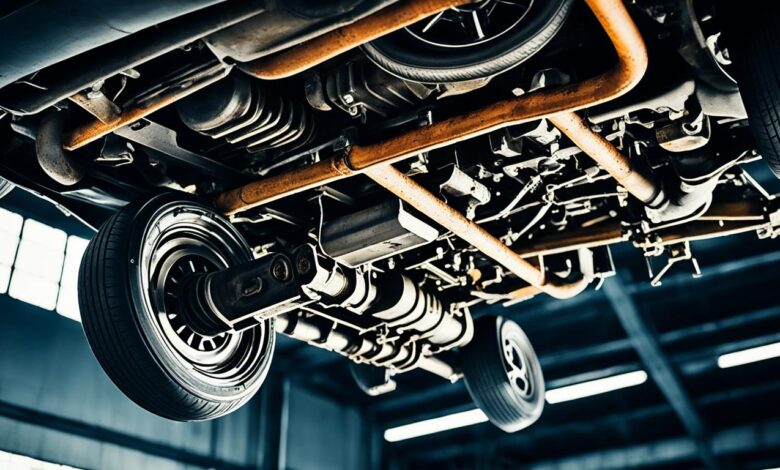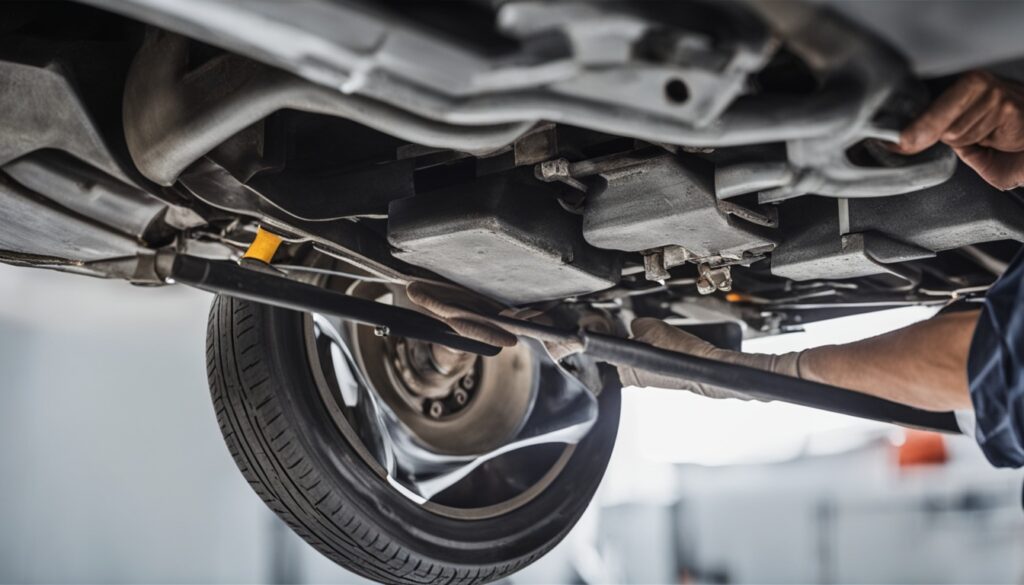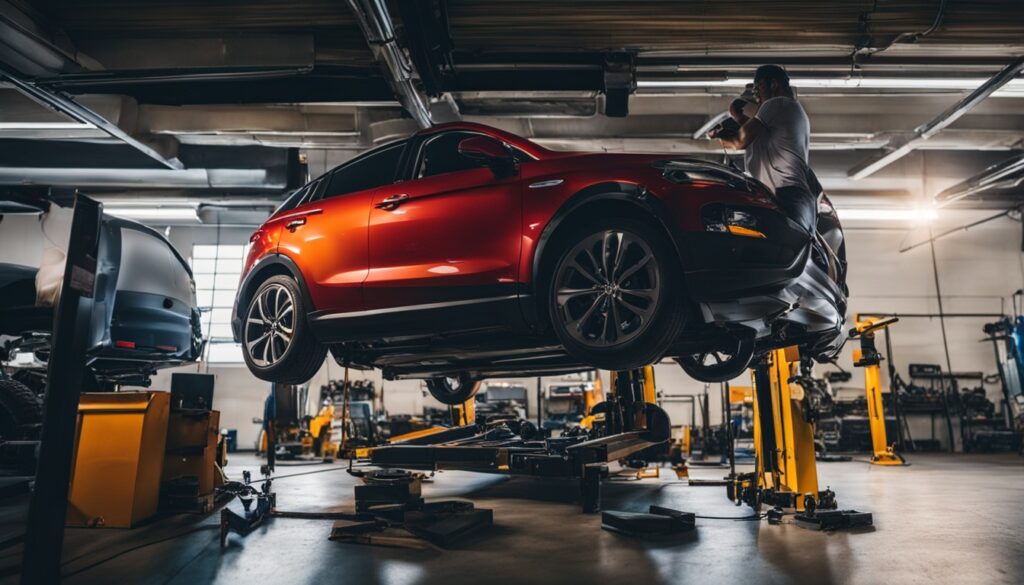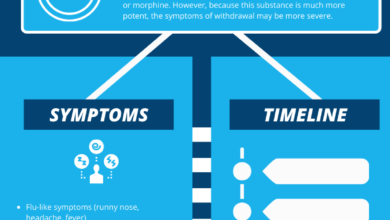Protect Your Car: Spotting Undercarriage Damage

Your car’s undercarriage health is vital for its performance, safety, and longevity. Damage to this area can impact handling, fuel efficiency, and your car’s structure.
This guide explores common causes of undercarriage damage and signs to watch for. We’ll also cover steps to prevent and address these issues, helping protect your vehicle investment.
Key Takeaways
- Over 60% of undercarriage damage is caused by impacts with road debris, such as potholes, rocks, and curbs.
- Suspension and steering components are among the most commonly damaged undercarriage parts.
- Vehicles with lower ground clearance or smaller rims are more susceptible to undercarriage damage from potholes.
- Prompt professional inspection and repair are crucial after any significant undercarriage impact to prevent further damage and ensure driving safety.
- Undercarriage rust repair can be costly, underscoring the importance of preventive maintenance and care.
What is Undercarriage Damage?
The undercarriage is the vital lower section of a vehicle. It houses key parts like the frame, suspension, brakes, and fuel lines. Damage here can greatly impact a car’s performance and safety.
Defining Undercarriage and Its Importance
The undercarriage supports the car’s weight and provides stability. It protects vital components from road hazards and the elements. Poor maintenance can lead to decreased fuel efficiency and safety issues.
Common Causes of Undercarriage Damage
- Driving over potholes, speed bumps, or other road debris can cause dents, scrapes, and punctures to the undercarriage components.
- Exposure to salt, water, and other environmental factors can lead to corrosion and rust formation, weakening the structural integrity of the undercarriage.
- Frequent off-road driving or traversing through muddy terrain can subject the undercarriage to increased wear and tear.
Ignoring undercarriage damage can lead to serious problems. These may include suspension issues and fluid leaks. Regular inspections and maintenance are key to keeping your vehicle’s undercarriage healthy.
| Undercarriage Repair Cost Estimates | Cost Range |
|---|---|
| Rust Repair | $150 to $2,000 |
| Frame Rust Repair | $2,000 to $3,500 |
| Exhaust Pipe Repair | $125 to $300 |
| Transmission Repair | $80 to $400 |
| Suspension Repair | $200 to $1,500 |
The data shows that fixing undercarriage damage can be costly. It’s crucial to address any issues quickly to avoid high repair bills.
Consequences of Ignoring Undercarriage Damage
Neglecting undercarriage damage can seriously impact your vehicle’s performance and safety. It may lead to suspension failure, brake problems, and fuel system malfunctions. These issues put you at risk on the road.
Suspension problems can affect your vehicle’s handling and ride quality. This makes it harder to control your car. Leaks in fuel or brake lines pose significant safety risks.
Unattended undercarriage damage can speed up corrosion and rust. This results in more extensive and costly repairs later. According to industry experts, neglecting undercarriage issues can result in escalating repair costs for accident victims, as the damage worsens over time.
| Consequence | Impact |
|---|---|
| Suspension Failure | Compromised handling and ride quality |
| Brake Issues | Increased safety risks |
| Fuel System Problems | Potential fire hazard |
| Increased Repair Costs | More extensive and costly repairs over time |
Ignoring undercarriage damage can have far-reaching effects on your safety and finances. Addressing these issues quickly helps avoid costly repairs. It also ensures your vehicle stays in top condition.
“Ignoring undercarriage damage can compromise the safety of your vehicle, leading to poor handling and an increased risk of accidents.”
Visual Inspection: Signs of Undercarriage Damage
Regular undercarriage checks can spot problems early. A thorough look can reveal signs of damage needing attention. Here are key things to watch for:
Dents, Scrapes, and Holes in Plastic Components
Check plastic parts like splash shields and belly pans closely. Look for dents, scrapes, or holes that show impact damage. These issues can harm the parts’ protective function.
If left unfixed, they may lead to bigger problems. Address any damage promptly to maintain your vehicle’s health.
Leaks and Rust Formation
Search for fluid leaks from suspension, brakes, or other key systems. Also, look out for rust or corrosion signs. These can weaken the undercarriage over time.
Catching leaks and rust early is vital. It prevents more serious issues from developing later on.
| Inspection Item | Potential Issue | Recommended Action |
|---|---|---|
| Plastic Components | Dents, Scrapes, Holes | Replace or repair damaged parts |
| Leaks | Suspension, Brakes, Fluids | Identify source and repair |
| Rust and Corrosion | Structural Integrity Issues | Address rust promptly to prevent further damage |
Regular undercarriage checks help maintain your car’s health and safety. Visual inspection is a key part of overall undercarriage care.
Preventing Undercarriage Damage
Your car’s undercarriage is vital for its longevity and performance. Taking proactive steps can protect this crucial component from road damage. Mindful driving and regular maintenance can reduce the risk of undercarriage issues.
Driving Habits to Avoid Road Hazards
Potholes, speed bumps, and road obstacles can damage your car’s underside. Stay alert while driving and avoid these hazards when possible. Slow down on uneven surfaces and keep a safe distance from other vehicles.
This allows you to spot and react to potential road dangers. By doing so, you’ll minimize impact on your vehicle’s undercarriage.
Regular Maintenance and Cleaning
Inspect and clean your car’s undercarriage often to prevent long-term damage. Wash the underside regularly, especially after driving in harsh conditions. This removes dirt, debris, and corrosive substances that can harm protective coatings.
Schedule professional maintenance checks to catch issues early. This can help you avoid more serious problems down the road.
Protecting your undercarriage extends your vehicle’s life and maintains its performance. It also preserves your car’s safety and value. Regular care today can prevent costly repairs tomorrow.
Undercarriage Damage from Road Salt
Road salt can severely damage a vehicle’s undercarriage in harsh winter regions. This winter treatment melts ice and improves driving conditions. However, it can harm vulnerable underbody components.
How Road Salt Accelerates Corrosion
Road salt acts as a powerful electrolyte, speeding up rusting on exposed metal parts. Saltwater splashes over a car’s undercarriage, seeping into body cavities and crevices. This creates ideal conditions for corrosion to thrive.
A 2009 car built in 2008 could develop severe rust within six years. This is especially true in “Rust Belt” regions. Montreal, Canada, is the worst city for rust, 16 times more prone than the Southwestern United States.
Cars in Wisconsin last half as long without rust compared to Seattle-based vehicles. This shows the dramatic regional differences in rust damage. Road salt causes $5 billion in yearly damages to vehicles and roads.
| Statistic | Explanation |
|---|---|
| Montreal is 16x more rust-prone than the Southwestern USA | Harsher winter conditions and more extensive road salt usage contribute to accelerated undercarriage corrosion in Montreal. |
| Wisconsin cars last half as long without rust compared to Seattle | The Rust Belt region’s heavy reliance on road salt leads to more severe and rapid undercarriage damage over time. |
| Road salt causes $5 billion in yearly damages to vehicles and roads | The widespread use of road salt takes a significant financial toll on infrastructure and vehicle maintenance costs. |
Drivers can protect their vehicles by washing the undercarriage often. Avoid driving through deep puddles when possible. Apply a protective coating to vulnerable areas. These steps help preserve your car’s undercarriage and prevent costly repairs.
DIY Fixes for Minor Undercarriage Damage
Your car’s undercarriage might need DIY repairs for minor issues. Small cracks or holes in plastic parts can be fixed with sealants or patching compounds. These quick fixes can prevent further damage temporarily.
Temporary Sealing and Patching
Sealants and patching compounds are common DIY solutions for minor undercarriage problems. They can effectively address small issues before they worsen. However, these fixes have limitations.
Professional help is necessary for extensive or complex undercarriage repairs. DIY methods are only suitable for minor damage.
- Sealants: Choose specialized automotive undercarriage sealants. These flexible, waterproof products can fill cracks or holes, preventing leaks and further damage.
- Patching Compounds: Plastic-based compounds can repair small dents or holes in plastic components. They help restore the protective barrier of your undercarriage.
Remember, DIY fixes offer temporary relief but aren’t long-term solutions. For significant or ongoing issues, consult a professional mechanic. They can provide more comprehensive repairs.

Regular inspections and proper maintenance are crucial for undercarriage health. Addressing minor problems quickly can prevent costly repairs later. Keep your car’s undercarriage in top shape with consistent care.
When to Seek Professional Repair
Minor undercarriage damage can be fixed at home. But major issues need a pro mechanic. Damage to suspension, frame, or structural components requires special tools and skills. A qualified tech should handle any safety-related problems.
Look out for signs that need expert help. If you see dents, scrapes, or holes in plastic parts, get a mechanic’s opinion. Also, have leaks or rust on the undercarriage checked right away.
Ignoring undercarriage problems can cause bigger issues. These may include suspension misalignment, brake failures, or structural damage. Professional repairs ensure proper assessment and fixes for critical parts.
| Indicator | Recommended Action |
|---|---|
| Visible dents, scrapes, or holes in plastic components | Consult a professional mechanic for inspection and repair |
| Leaks or rust formation on the undercarriage | Promptly address the issue with a qualified technician |
| Significant damage to suspension, frame, or structural components | Seek professional repair to ensure safety and proper functioning |
Stay alert and fix undercarriage issues early. This protects your car’s performance, safety, and value. For undercarriage concerns, it’s best to consult a professional repair expert.
The Role of Undercarriage Damage in Car Repair Costs
Ignoring undercarriage damage can lead to serious money problems. Unattended issues can grow, causing more expensive repairs later. Damaged parts can hurt your car’s performance and safety, resulting in higher repair bills.
Undercarriage damage can lower your car’s resale value. Big problems like frame rust can make it hard to get insurance. They might even make your car unsellable.
Regular maintenance and quick repairs can help reduce these costs. They also protect your investment in your car.
| Repair Type | Estimated Cost Range |
|---|---|
| Rust Repair on Undercarriage | $200 to $1,500 |
| Frame Rust Repair | $2,200 to $4,000 |
| Exhaust Pipe Repair | $100 to $300 |
| Transmission Repair | $50 to $400 |
| Suspension Repair | $200 to $2,000 |
These figures show that undercarriage damage costs can add up fast. Regular preventative maintenance can help reduce the financial impact. It can also protect your car’s resale value.
Insurance claims for undercarriage damage can be tricky. Keep good records and consider getting legal advice if needed.
“Neglecting undercarriage maintenance can lead to bigger car problems down the road, both in terms of safety and financial costs.”
Understanding undercarriage damage is key to keeping your car healthy and valuable. Quick action on issues can save you money in the long run.
Prioritize preventative maintenance to protect your car investment. This approach can help you avoid costly repairs and keep your car running smoothly.
Protecting Your Investment: Undercarriage Maintenance Tips
Maintaining your vehicle’s undercarriage is vital for its value and performance. Proactive care can extend your car’s life and protect your investment. Let’s explore two effective strategies for undercarriage protection.
Undercoating and Rust-Proofing
Undercoating creates a barrier against corrosion-causing elements. It shields metal parts from water, road salt, and other harmful factors. Regular treatments can prevent costly repairs in the future.
Covered Parking and Regular Inspections
Parking in a garage or carport reduces undercarriage exposure to damaging elements. This simple step can minimize the risk of corrosion and other damage. Regular visual checks help identify issues early on.
Proactive undercarriage care is crucial for your vehicle’s health and value. These tips will help keep your car in top shape for years to come.

Undercarriage Damage and Vehicle Safety
Undercarriage damage affects more than just your car’s looks. It can seriously impact your vehicle’s safety. Ignoring these problems puts everyone in the car at risk.
Damaged undercarriage can mess up your car’s suspension. This makes it harder to control, especially in bad weather. As a result, you’re more likely to have an accident.
Brake and fuel line leaks are even more dangerous. Leaky brake fluid can make it harder to stop. Fuel leaks increase the risk of fire.
To keep your car safe, fix undercarriage damage quickly. Regular checks help spot problems early. This allows for timely repairs and keeps you safe on the road.
| Safety Concern | Potential Consequences |
|---|---|
| Suspension Issues | Compromised handling and stability, increased risk of accidents |
| Brake System Leaks | Decreased braking effectiveness, heightened collision risk |
| Fuel System Leaks | Increased fire hazard, potential for catastrophic incidents |
Quick action on undercarriage damage keeps your car safe and stable. This gives you peace of mind on every trip.
Dealing with Insurance Claims for Undercarriage Damage
Filing an insurance claim is vital when your car has serious undercarriage damage. It’s key to document the damage well and work with your insurance company. This helps ensure a successful claim process.
Start by taking detailed photos of the damaged areas. Get repair estimates from a trusted mechanic. These documents are crucial for your insurance claim.
Check your policy details for coverage on undercarriage damage. This may include harm from road salt or debris. Talk openly with your insurer to speed up the claim process.
Sometimes, disputes arise over damage extent and repair costs. A personal injury lawyer can help in these cases. They can guide you through the claims process and fight for fair compensation.
Act quickly when dealing with undercarriage damage. Delays in getting help or filing claims can weaken your case. Being proactive improves your chances of a successful claim.
Good documentation is key for a successful insurance claim. Open communication with your insurer is also important. If needed, get legal help to ensure fairness. These steps protect your investment and reduce financial stress.
Conclusion
Protecting your vehicle’s undercarriage is vital for undercarriage maintenance and safety. Regular inspections and timely repairs can extend your car’s life and performance. Invest in protective coatings to avoid costly repairs and keep your vehicle in top shape.
Proper undercarriage maintenance enhances vehicle longevity and ensures a safer driving experience. Addressing issues promptly prevents further damage and component failures. Regular upkeep can lead to significant cost savings by catching problems early.
Prioritizing undercarriage care is a smart investment in your car’s future. It ensures optimal performance and safety. Follow these tips for a smooth, secure, and cost-effective driving experience for years to come.
FAQ
What is the undercarriage of a vehicle?
The undercarriage is the bottom part of a car. It includes the frame, suspension, brakes, and fuel lines. These components are vital for your vehicle’s performance.
What are the common causes of undercarriage damage?
Potholes and speed bumps can damage your car’s undercarriage. Environmental elements like salt and water also pose risks. Be careful when driving over road hazards.
What are the consequences of ignoring undercarriage damage?
Ignoring undercarriage damage can lead to serious issues. You might face suspension problems, leaks, and safety concerns. Unrepaired damage can also cause rust and more expensive repairs later.
How can I identify signs of undercarriage damage?
Check for dents or holes in plastic parts like splash shields. Look for scrapes on the belly pan. These can show impact damage.
Also, watch out for leaks or rust forming. Regular inspections can help catch problems early.
How can I prevent undercarriage damage?
Drive carefully to avoid potholes and obstacles. Clean and inspect your undercarriage regularly. Apply protective coatings to shield against damage.
How does road salt affect the undercarriage?
Road salt speeds up rusting on metal parts. It acts as a powerful electrolyte. Wash your undercarriage often and use protective coatings to fight salt’s effects.
Can I repair minor undercarriage damage myself?
You can fix small cracks in plastic parts with sealant or patching compound. For bigger issues, seek professional help. Complex repairs need expert attention.
When should I seek professional help for undercarriage repairs?
Get professional help for major suspension or frame damage. Experts have the right tools and skills. Always address safety issues with a qualified technician.
How can undercarriage damage impact the cost of car repairs?
Ignoring undercarriage damage leads to costlier repairs later. It can harm other car parts too. Severe damage may lower your car’s resale value and affect insurance coverage.
How can I protect my vehicle’s undercarriage?
Use undercoating or rust-proofing products to shield against corrosion. Park in a covered area like a garage. This reduces exposure to damaging elements like salt and water.
How does undercarriage damage affect vehicle safety?
Undercarriage damage can affect crucial parts like suspension and brakes. This can harm your car’s handling and stability. It may also create serious safety risks.
Can I file an insurance claim for undercarriage damage?
You might file a claim for major undercarriage damage from collisions. Document the damage thoroughly. Work closely with your insurance provider to process the claim.


